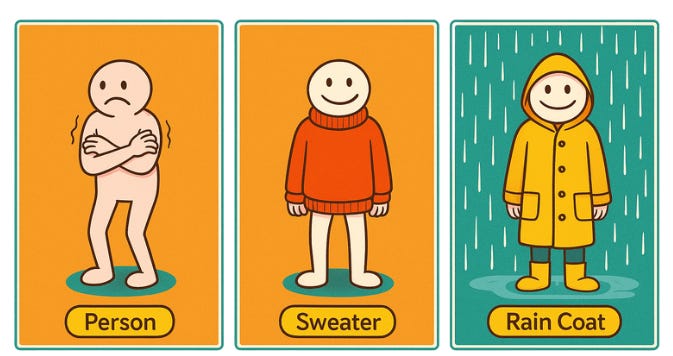Understanding the Decorator Design Pattern
Enhancing Object Behavior Dynamically Without Modifying Existing Code
Design patterns are like recipes in software development. They don’t give you the entire meal, but they provide a structure you can follow to solve recurring problems in a clean and maintainable way.
One such structural pattern is the Decorator Pattern. It allows you to add new behaviors to an object dynamically, without altering its original code.
Let’s break it down with a simple, relatable example: a person wearing clothes.
The Problem
Imagine you have a Person. They can wear a Sweater, and later, when it rains, they can put on a Raincoat.
But here’s the catch:
You don’t want to modify the
Personclass every time you add a new clothing type.You also don’t want a huge inheritance tree like
PersonWithSweater,PersonWithRaincoat,PersonWithSweaterAndRaincoat, and so on.
That’s where the Decorator Pattern shines!
When to Use the Decorator Pattern
You should consider using the Decorator pattern in the following scenarios:
Adding New Features: You want to add extra features to objects without changing their core structure. It’s like putting toppings on a pizza without changing the pizza itself.
Avoiding Messy Code: You want to avoid having too many different classes for all possible combinations of features. Instead, you can mix and match decorators as needed.
Open for Extension, Closed for Modification: You want to make your code ready for future changes by allowing new features to be added without messing up existing code. This aligns with the Open/Closed Principle.
The Solution with Decorator Pattern
Think of the Person as the core object, and every clothing layer (Sweater, Raincoat, Jacket, etc.) as a decorator that wraps around the person, adding new features.
Step 1: Define the Component
public interface IPerson
{
void DressUp();
}Step 2: The Concrete Component
public class Person : IPerson
{
public void DressUp()
{
Console.WriteLine("Person is ready.");
}
}Step 3: Create the Base Decorator
public abstract class ClothingDecorator : IPerson
{
protected IPerson _person;
public ClothingDecorator(IPerson person)
{
_person = person;
}
public virtual void DressUp()
{
_person.DressUp();
}
}Step 4: Add Concrete Decorators
Sweater Decorator:
public class Sweater : ClothingDecorator
{
public Sweater(IPerson person) : base(person) { }
public override void DressUp()
{
base.DressUp();
Console.WriteLine("Wearing a cozy sweater.");
}
}Raincoat Decorator:
public class Raincoat : ClothingDecorator
{
public Raincoat(IPerson person) : base(person) { }
public override void DressUp()
{
base.DressUp();
Console.WriteLine("Putting on a raincoat.");
}
}Step 5: Use the Decorators
class Program
{
static void Main(string[] args)
{
IPerson person = new Person();
// Person puts on a sweater
IPerson sweaterPerson = new Sweater(person);
// Person puts on a raincoat over the sweater
IPerson fullyDressed = new Raincoat(sweaterPerson);
fullyDressed.DressUp();
}
}Output:
Person is ready.
Wearing a cozy sweater.
Putting on a raincoat.Why Use Decorator Pattern?
✅ Flexibility – Add new behaviors without touching existing code.
✅ Composition over inheritance – Avoids deep and rigid class hierarchies.
✅ Dynamic behavior – You can wrap objects in different combinations at runtime.
Real-Life Analogy
Sweater → Keeps you warm.
Raincoat → Protects you from rain.
Both together → You stay warm and dry.
That’s exactly how the decorator pattern lets you layer responsibilities dynamically.
Conclusion
The Decorator Pattern is perfect when you want to enhance the functionality of objects without changing their base implementation.
Just like you layer clothes depending on the weather, in programming, you can layer responsibilities using decorators.
Next time you’re adding new behavior, think: Should I extend this class? Or can I just decorate it?
👉 Full working code available at:
🔗https://sourcecode.kanaiyakatarmal.com/DecoratorDesignPattern
I hope you found this guide helpful and informative.
Thanks for reading!
If you enjoyed this article, feel free to share it and follow me for more practical, developer-friendly content like this.


